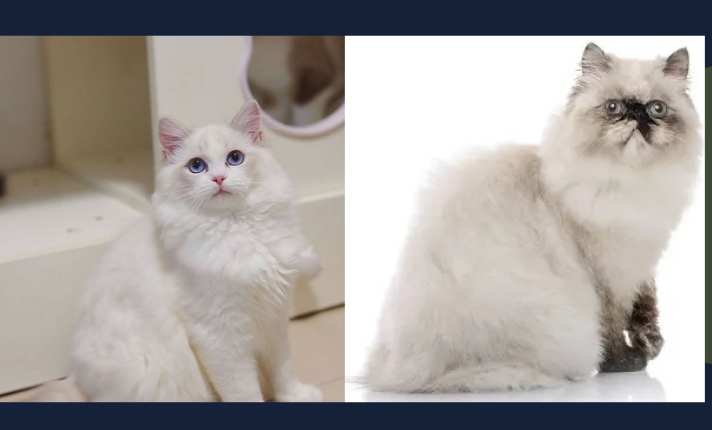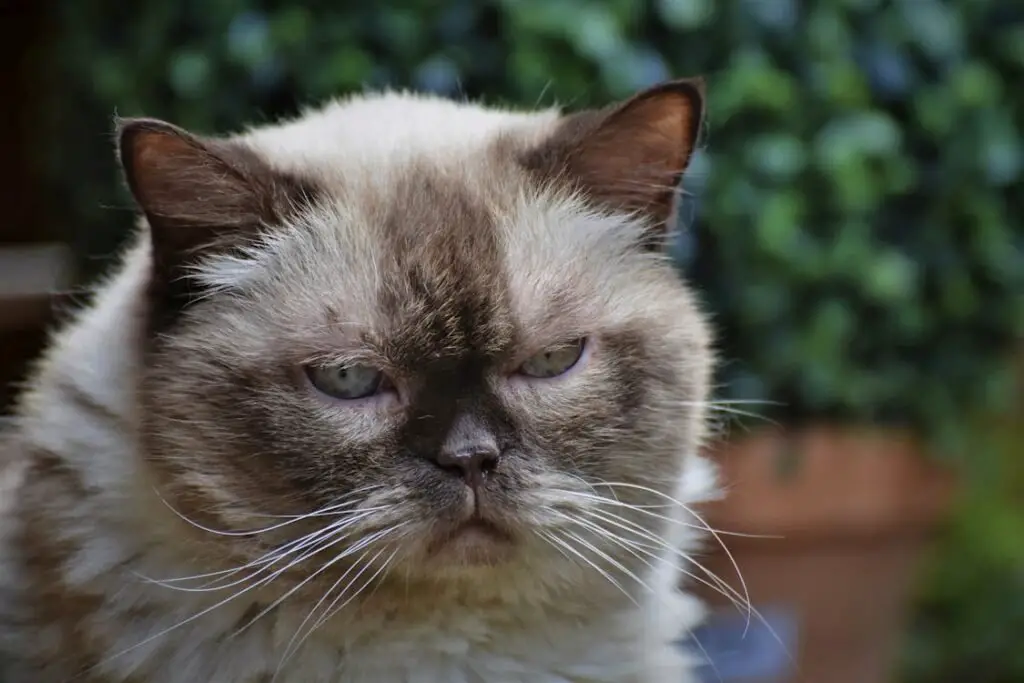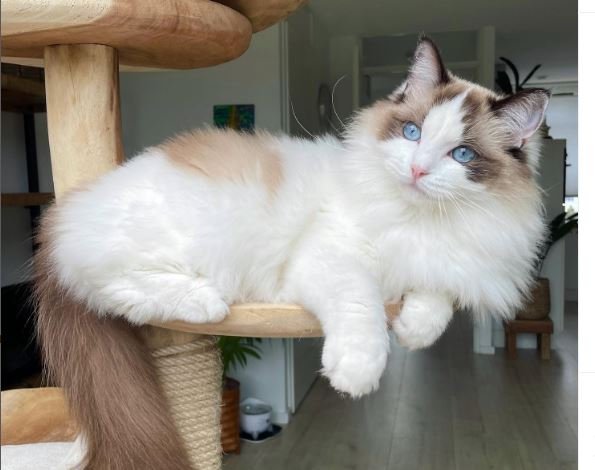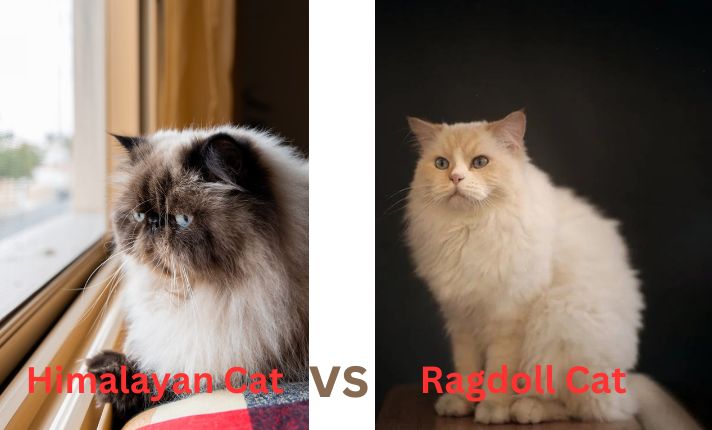If you are a cat lover, you’ve likely come across the Himalayan and Ragdoll breeds—two stunning and popular cat types known for their affectionate personalities and beautiful appearances. While both of these breeds are highly sought after, they are also very different in terms of their origins, physical features, personality traits, grooming needs, and energy levels.
Himalayans are medium-sized cats with flatter faces, requiring daily grooming due to their dense fur, while Ragdolls are larger, have a more traditionally shaped face, and are known for their relaxed and social “puppy-like” personality. Understanding these differences will help you determine which of these charming felines is the best fit for your home and lifestyle.
In this detailed article, we will explore every aspect of these two breeds so that you can make an informed decision.
Himalayan vs Ragdoll: Main Differences
Sure, here’s a concise comparison table for Himalayan vs Ragdoll cats:
| Feature | Himalayan Cat | Ragdoll Cat |
|---|---|---|
| Height | 10-12 inches | 9-11 inches |
| Weight | 7-12 pounds | 10-20 pounds |
| Lifespan | 9-15 years | 12-17 years |
| Personality | Affectionate, calm, gentle | Affectionate, laid-back, social |
| Price | $600-$1,500 | $800-$2,000 |
| Suitable For | Quiet homes, attention seekers | Families, interactive households |
| Activity Level | Moderate | Low to moderate |
| Family Friendly | Yes | Yes |
Origin Of Himalayan Cat vs Ragdoll Cat
Himalayan Cats
The Himalayan cat is a hybrid breed that originated from crossbreeding Persian cats with Siamese cats. The breed was initially developed in the United States and the United Kingdom in the early 1930s, with breeders striving to combine the Persian’s beautiful, long, luxurious fur with the Siamese’s striking pointed color pattern.
The result was the Himalayan—a cat that possesses the best of both worlds. Himalayans have the flat-faced (brachycephalic) features of Persians, with the striking blue eyes and pointed coloration of Siamese cats.
Ragdoll Cats
The Ragdoll cat was developed by Ann Baker, a breeder in California, in the early 1960s. Baker selectively bred cats with specific personality traits—calm, docile, and affectionate—to create the Ragdoll breed.
The breed’s name comes from its tendency to go limp and relaxed when held, much like a child’s ragdoll toy. This trait, combined with their beautiful blue eyes, silky coat, and large size, quickly made Ragdolls one of the most popular cat breeds.

Appearance Of Ragdoll vs Himalayan
Size and Build
Himalayans are medium-sized cats with a sturdy build. They typically weigh between 7 to 12 pounds. They have a cobby body type, meaning they are compact with a broad chest, short legs, and a round body.
Their flat face, also known as brachycephalic, is one of their most distinctive features. Their rounded head, small ears, and large, round blue eyes.
Ragdoll Cats are one of the largest domesticated cat breeds, with males often weighing between 15 to 20 pounds and females weighing between 10 to 15 pounds. They have a muscular yet soft build, with a broad chest and a rectangular body shape. Ragdolls have a proportionate head, with medium-sized ears.
Unlike Himalayans, Ragdolls have a more traditional cat face, which contributes to their relaxed, friendly expression.
Coat and Colors
Himalayan Cat: Himalayans have long, dense coats that are silky and luxurious. They require regular grooming to maintain their coat’s beauty and prevent matting. Himalayans come in various pointed colorations that resemble the Siamese, including seal, blue, chocolate, lilac, red, and cream. These points are present on their face, ears, paws, and tail, which gives them a striking contrast against their lighter body color.
Ragdolls have semi-long fur that is soft and plush, giving them a cuddly appearance. Unlike the dense coat of a Himalayan, the Ragdoll’s fur is silkier and less prone to matting, which makes grooming easier. Ragdolls are famous for their stunning blue eyes, which are large.
They come in several color patterns, including colorpoint, mitted, and bicolor. Their coat colors include seal, blue, chocolate, lilac, red, and cream, similar to the Himalayan. The bicolor pattern, with its distinctive inverted V marking on the face, is one of the most recognizable features of the breed.
Ragdoll vs Himalaya Temperament & Personality
Himalayan Cats
Himalayans are affectionate and gentle but are also more independent compared to Ragdolls. They enjoy spending time with their owners but can be aloof at times, preferring to observe from a distance rather than actively seeking out attention. Himalayans have a playful streak but are generally not as active as some other breeds. They tend to enjoy quiet environments and can be a bit shy around strangers.
Their personality is often a mix of Persian calmness and Siamese curiosity, making them more reserved and less social than Ragdolls. They thrive in stable, calm households without too much noise or chaos.

Ragdoll Cats
Ragdolls are known for their loving, “puppy-like” personalities. They are extremely sociable and often follow their owners around the house, eager to be involved in whatever activity is happening.
Unlike Himalayans, Ragdolls love being picked up and cuddled and are famous for their tendency to go limp when held, which makes them excellent companions for those who want a cat that loves physical affection. Ragdolls are also more tolerant of noise and activity, which makes them better suited for busy households compared to the more reserved Himalayan.
Himalayan vs Ragdoll Of Grooming Requirements
Himalayan Cats
Due to their long, dense fur, Himalayans require daily grooming to prevent tangles and matting. Their coat is prone to knots, and regular brushing is essential to keep their fur looking its best. In addition to brushing, Himalayans are prone to tear staining around their eyes, particularly because of their flat faces, which can cause tears to overflow.
Owners will need to clean the area around their eyes regularly to prevent staining and discomfort. Himalayans also benefit from regular baths to help maintain their coat’s condition and reduce shedding.
Ragdoll Cats

Ragdolls have semi-long fur that is less prone to matting, making them easier to groom compared to Himalayas. Brushing them two to three times a week is usually sufficient to keep their coat healthy and free of tangles. While Ragdolls shed, their fur is less dense, and regular grooming helps reduce the amount of loose hair around the house.
Unlike the Himalayas, Ragdolls do not usually have tear-staining issues, which makes their grooming routine a bit less intensive.
Health Concerns
Himalayan Cats:
Himalayans are prone to several health issues, mainly due to their brachycephalic facial structure. Their flat faces can lead to breathing difficulties, as their nasal passages are shorter and can become easily obstructed. They are also susceptible to dental problems, as their jaws are more compact, leading to overcrowded teeth.
Another common issue is excessive tearing, which can lead to tear staining and potential eye infections if not properly managed. Additionally, Himalayans are at risk for polycystic kidney disease (PKD), a hereditary condition that affects the kidneys.
Regular veterinary checkups are essential to monitor their health and catch any potential issues early.
Ragdoll Cats:
Ragdolls are generally a healthy breed, but they are prone to some hereditary conditions. One of the most common health concerns in Ragdolls is hypertrophic cardiomyopathy (HCM), a form of heart disease that causes the heart walls to thicken, potentially leading to heart failure. Responsible breeders often screen for HCM to reduce the risk of passing this condition on to kittens.
Ragdolls can also be prone to urinary tract issues, so it’s important to provide them with a diet that supports urinary health. Regular veterinary checkups and a healthy diet are key to ensuring a long, healthy life for a Ragdoll cat.
Which Breed is Best for You
Choosing between a Himalayan and a Ragdoll depends largely on your lifestyle and preferences:
If you want a sociable cat, that loves attention, and is easygoing with a slightly lower grooming requirement, the Ragdoll is likely the better fit. Ragdolls are great for families, individuals who want a playful yet relaxed pet, or anyone who enjoys a cat that acts more like a dog in its loyalty and affection.
If you are looking for a laid-back, beautiful cat that enjoys peaceful settings and doesn’t mind regular grooming, the Himalayan might be the perfect match for you. They are ideal for individuals or families who prefer a calm, predictable environment and are willing to invest time in grooming and care.
FAQs
Are Ragdolls more affectionate than Himalayans?
Ragdolls are generally more sociable and affectionate compared to Himalayas. They enjoy being held and interacting with their owners, while Himalayans can be more reserved and selective in showing affection.
Do Ragdolls and Himalayans get along with other pets?
Both breeds can get along well with other pets, but Ragdolls are generally more accepting and sociable, making them better suited for homes with multiple animals. Himalayans may take longer to warm up to new pets but can coexist peacefully once they are comfortable.

Hey guys, My name is Simon Smith. I’m from Canada and live near Victoria
I live with my sweet family and have 20+ Ragdolls of different types. I love them as my children. My profession is as a hotel manager.
I love to keep Ragdolls and grow their breeder case. I have 7 years of experience.
I’m an expert in cat care. So, I’m here to provide you with new information about my cats daily. This is my blog website, so I request that you kindly visit our site daily.
If you’re a Ragdolls lover and you have any questions or confusion about cats, text me on the Contact Us page or Gmail.
Thank u
